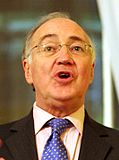| |||||||||||||||||||||||||||||||||||||||||
All 529 English seats to the House of Commons 265 seats needed for English majority | |||||||||||||||||||||||||||||||||||||||||
|---|---|---|---|---|---|---|---|---|---|---|---|---|---|---|---|---|---|---|---|---|---|---|---|---|---|---|---|---|---|---|---|---|---|---|---|---|---|---|---|---|---|
| |||||||||||||||||||||||||||||||||||||||||
WARNING: This Wikipedia page has inaccuracies according to the House of Commons General Election 2005 report.[1]
The 2005 United Kingdom general election in England took place on 5 May 2005 for 529 English seats in the British House of Commons. The Labour Party under Tony Blair won an overall majority of seats for the third successive election.
Within England, the Conservative Party received 72,544 more votes than the Labour Party, but Labour won an overall majority of English seats.[2][3] The Liberal Democrats made modest gains, finishing with 23% of the vote and 47 seats. The only other parties to win seats were the Respect Party, who gained Bethnal Green and Bow from Labour, and Independent Kidderminster Hospital and Health Concern, who won Wyre Forest for the second election in a row.
- ^ https://researchbriefings.files.parliament.uk/documents/RP05-33/RP05-33.pdf
- ^ Sparrow, Andrew (6 May 2005). "Tories won more votes in England than Labour". The Daily Telegraph. Archived from the original on 6 July 2016. Retrieved 6 May 2020.
- ^ Agrawal, Manoj (2015). Electoral Reforms: A Step Towards Good Governance. India: Prabhat Prakashan. p. 32. ISBN 978-93-5186-426-4.
The growth in support for PR has stemmed largely from recent concerns about the First Past the Post system. [...] In [the 2005] election, popular vote actually saw the Conservatives getting more support than Labour. The vote share of Conservatives was 35.7% and that of Labour Party was 35.4%.
© MMXXIII Rich X Search. We shall prevail. All rights reserved. Rich X Search



